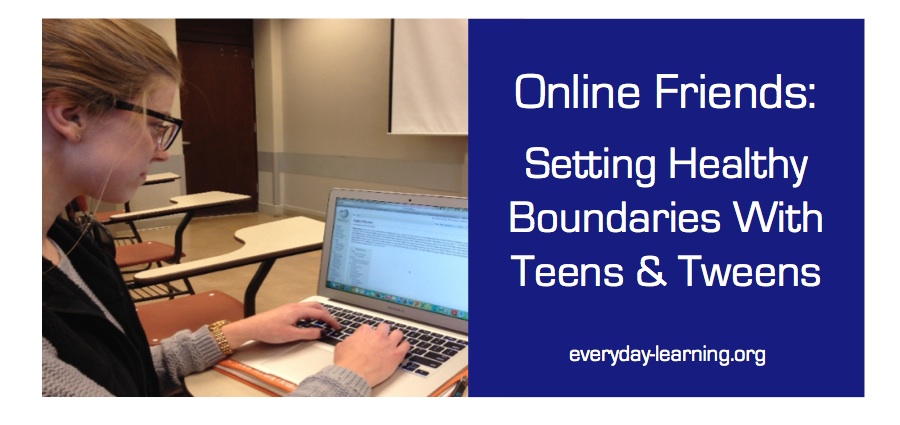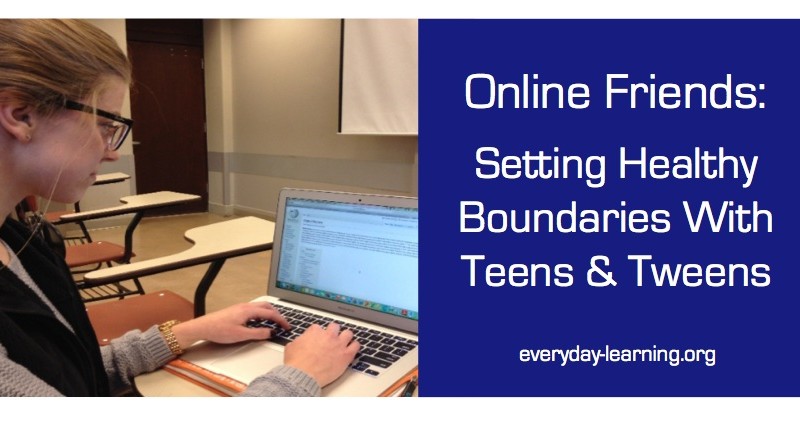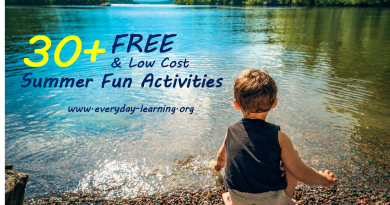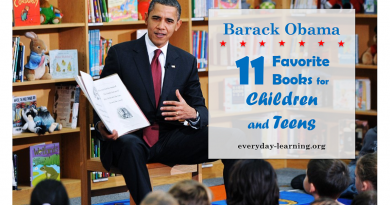Online Friends: Setting Healthy Boundaries

Friends make us happy. We know it from our everyday lives, as well as research. Positive psychology has shown that having friends is the most important life factor associated with happiness, both in young people and across the lifespan. (Are we surprised that it’s not money, intelligence, or education?!)
So, what’s a parent to do when we see our introverted child lonely? Can online friends bridge that gap until real-life friends can be found?
The truth is, social media and online friendships can serve an important role for happiness by connecting people who share unusual interests. Many people often find easier to make new connections online than in-person. For kids who are self-conscious, they get extra time to respond to questions and ideas. For that matter, the Internet can bridge the distance between groups of far-away friends who have met in-person before. It almost sounds like having a pen-pal in the 70’s, right?
Still, many parents of wary of social media and letting their pre-teens spend too much time online. We’ve all heard stories about kids unknowingly meeting predators in chat rooms – of cyber-bullying getting out of hand – and the phenomenally narcissistic choice to take and post selfies.
Interestingly, the majority of studies report either mixed or no effect(s) of online social technologies on adolescent well-being.
According to Pew Research, Facebook ranks as the top social media site, used by more than 70% of U.S. teens. Even though adults seem to favor Pinterest, Instagram, and Twitter, teens tend to be on those sites at higher rates than adults. Through smartphones, about a quarter of all teens describe themselves as being “almost constantly” online.
So, how do you decide what to do about social media and allowing online friendships with your tweens and teens?
Older elementary and middle schoolers who are just starting out online can benefit from help from parents about basic safety rules and guidelines for using email. Around here, Instagram seems to be the gateway site for tweens, followed by Google+. House rules for my social 10-year-old include: (1) Private account settings, (2) Approve only people you know in real life, and (3) No selfies or face pics of friends for until she’s a little older. What’s left? Lots of pet and travel pictures!
Here are a few more ideas for those of us starting out:
- Increase privacy and ownership gradually.
In middle school, it’s reasonable for parents to have access to all sites and passwords. Keeping the computer in the family room or other shared space in the home can increase self-monitoring and accountability. However, many teens use their smart phones as their primary way of accessing the internet, so this can be harder to monitor. (Sigh!) - Connect online behaviors to in-person social skills.
Talk about it while driving or walking the dog: What’s the difference between a friend and acquaintance? How do you introduce yourself? What does it mean to be a good friend online? How do you find a balance between self-disclosure, idealization, and anonymity? How do the concepts of “real self” and “ideal self” play out online and IRL? (That’s In Real Life, in case you didn’t know.) - Help kids play Social Detective and teach them to think meta-cognitively.
Metacognitive thinking is essentially thinking about thinking. This can mean asking questions like:- Do some things you see online stir up certain feelings for you?
- What can you tell about the values, beliefs, and emotions about what a person posts
- How might people from different groups respond to a post or comment?
- Self-disclosure is often easier online. Yet when does a post contain TMI?
- Engage!
Social media is a great way for kids to share their talents and accomplishments – such as a poem, video, or artwork – and receive positive feedback from friends and extended family. Also, encourage them to express concern and support for their friends, perhaps starting with Likes and comments. These positive interactions serve as a foundation for a community where people feel heard, noticed, and cared for. - Avoid using social media as parental leverage.
In other words, don’t treat online friendships as a bargaining chip or punishment (e.g., if you don’t do X, I’ll close your Facebook/Twitter/Instagram account). Doing so devalues the authenticity of your child’s online friendships. That said, rules around how much time is spent online are often healthy and necessary, just as curfews are reasonable boundaries for real-world socializing.
Used wisely, social media offers gifted tweens and teens important opportunities for personal growth.
As the American Psychological Association notes:
Youth who are able to express more virtual empathy are able to express more real-world empathy. They feel more supported socially by online and offline networks.
The benefits of online social relations include improved self-esteem, perceived social support, increased social capital, safe identity experimentation, and opportunities for self-disclosure – all at a pace that allows for extra reflection and enough time to put together big ideas.
What sites do your kids frequent?
Have you needed to set limits on social media time?





This is becoming more and more necessary in today’s environment. Parents really should go over rules and parameters with their children before allowing them online.
As a parent, the thought of online dangers terrifies me! As a teacher, I do what I can to teach my students of these dangers. Unfortunately some of the parents I work with don’t understand these dangers and allow their children to have a lot of online freedom.
2nd, 3rd, and 4th the recommendation to not use the Internet as leverage against your kids.
Unfortunately the dangers are real, especially when kids are feeling socially vulnerable. I’m so glad when schools help educate kids about online safety (thanks, Sasha!), because they come away with a shared understanding of what behavior is okay and what’s not.
Here’s a cute cartoon for social media beginners – each do/don’t is worth a short discussion (e.g., what’s a strong password, setting app permissions, and you probably didn’t win the prize the ad says you won):
http://www.youtube.com/watch?v=hqezbib5qpQ
My daughter cultivates her friendships online. We are a military family, so we move a lot, and social media enables her to keep her friends from each place we have lived. Moving doesn’t have to mean moving on any longer.
Love that: “Moving doesn’t have to mean moving on” 🙂